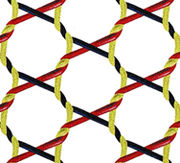
Tulle netting
Encyclopedia

Silk
Silk is a natural protein fiber, some forms of which can be woven into textiles. The best-known type of silk is obtained from the cocoons of the larvae of the mulberry silkworm Bombyx mori reared in captivity...
, nylon
Nylon
Nylon is a generic designation for a family of synthetic polymers known generically as polyamides, first produced on February 28, 1935, by Wallace Carothers at DuPont's research facility at the DuPont Experimental Station...
, and rayon
Rayon
Rayon is a manufactured regenerated cellulose fiber. Because it is produced from naturally occurring polymers, it is neither a truly synthetic fiber nor a natural fiber; it is a semi-synthetic or artificial fiber. Rayon is known by the names viscose rayon and art silk in the textile industry...
. Tulle is most commonly used for veil
Veil
A veil is an article of clothing, worn almost exclusively by women, that is intended to cover some part of the head or face.One view is that as a religious item, it is intended to show honor to an object or space...
s, gown
Gown
A gown is a loose outer garment from knee- to full-length worn by men and women in Europe from the early Middle Ages to the 17th century ; later, gown was applied to any woman's garment consisting of a bodice and attached skirt.A long, loosely-fitted gown called a Banyan was worn by men in the 18th...
s (particularly wedding gowns), and ballet tutu
Ballet tutu
A tutu is a skirt worn as a costume in a ballet performance, often with attached bodice. It might be single layer, hanging down, or multiple layers starched and jutting out.There are several types of ballet tutu:...
s. Tulle comes in a wide array of colors and it can also easily be dyed to suit the needs of the consumer. It is readily available.
The name comes from Tulle
Tulle
Tulle is a commune and capital of the Corrèze department in the Limousin region in central France. It is also the episcopal see of the Roman Catholic Diocese of Tulle...
, a city in the southern central region of France. Tulle was well known as a center of lace
Lace
Lace is an openwork fabric, patterned with open holes in the work, made by machine or by hand. The holes can be formed via removal of threads or cloth from a previously woven fabric, but more often open spaces are created as part of the lace fabric. Lace-making is an ancient craft. True lace was...
and silk
Silk
Silk is a natural protein fiber, some forms of which can be woven into textiles. The best-known type of silk is obtained from the cocoons of the larvae of the mulberry silkworm Bombyx mori reared in captivity...
production in the 18th century, and early tulle netting probably originated in this French city. Tulle netting certainly appeared earlier in Parisian ballet costume than in most other nations, suggesting that tulle netting may have been more readily available there than elsewhere.
The majority of tulle is actually bobbinet
Bobbinet
Bobbinet or genuine tulle is a specific type of tulle netting which has been made in the United Kingdom since the invention of the bobbinet machine in 1806 by John Heathcoat. John Heathcoat coined the term "bobbin net", or bobbinet as it is spelled today, to distinguish his machine-made tulle from...
, invented in Britain in the early 19th century. Bobbinet is made by wrapping the weft thread around the warp thread, creating a strong hexagonal design which tends not to twist or fall out of shape, because the wrapped threads maintain a state of tension. The result is tulle netting which is lightweight and surprisingly strong and durable for its weight.

There are other applications for tulle netting. Finely woven tulle netting is excellent for insect control
Mosquito net
A mosquito net offers protection against mosquitos, flies, and other insects, and thus against diseases such as malaria, dengue fever, yellow fever, and various forms of encephalitis, including the West Nile virus, if used properly and especially if treated with an insecticide, which can double...
, for example. The tulle netting can be stretched over potentially vulnerable plants to keep insects out, and it can also be used to create an insect tent over a bed to protect sleepers. The starch keeps the tulle netting from collapsing, and the holes allow air to freely circulate through the material.
Decorative ornaments can also be made from tulle netting. It is frequently used to wrap up party favors and gifts, especially for weddings and baby showers. Scraps of tulle netting are sometimes used in quilting and crafts as well, to add texture to a project. Multicolored tulle netting is often used for this purpose, to create tulle flowers and other ornamental accents.

